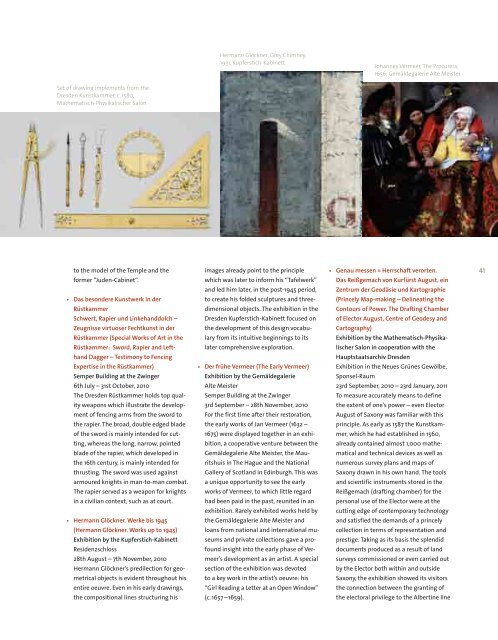Annual Report 2010 - Staatliche Kunstsammlungen Dresden
Annual Report 2010 - Staatliche Kunstsammlungen Dresden
Annual Report 2010 - Staatliche Kunstsammlungen Dresden
You also want an ePaper? Increase the reach of your titles
YUMPU automatically turns print PDFs into web optimized ePapers that Google loves.
set of drawing implements from the<br />
<strong>Dresden</strong> Kunstkammer, c. 1580,<br />
Mathematisch-Physikalischer salon<br />
to the model of the Temple and the<br />
former “JudenCabinet“.<br />
• Das besondere Kunstwerk in der<br />
Rüstkammer<br />
Schwert, Rapier und Linkehanddolch –<br />
Zeugnisse virtuoser Fechtkunst in der<br />
Rüstkammer (Special Works of Art in the<br />
Rüstkammer: Sword, Rapier and Lefthand<br />
Dagger – Testimony to Fencing<br />
Expertise in the Rüstkammer)<br />
Semper Building at the Zwinger<br />
6th July – 31st October, <strong>2010</strong><br />
The <strong>Dresden</strong> Rüstkammer holds top quality<br />
weapons which illustrate the development<br />
of fencing arms from the sword to<br />
the rapier. The broad, double edged blade<br />
of the sword is mainly intended for cutting,<br />
whereas the long, narrow, pointed<br />
blade of the rapier, which developed in<br />
the 16th century, is mainly intended for<br />
thrusting. The sword was used against<br />
armoured knights in mantoman combat.<br />
The rapier served as a weapon for knights<br />
in a civilian context, such as at court.<br />
• Hermann Glöckner. Werke bis 1945<br />
(Hermann Glöckner. Works up to 1945)<br />
Exhibition by the Kupferstich-Kabinett<br />
Residenzschloss<br />
28th August – 7th November, <strong>2010</strong><br />
Hermann Glöckner’s predilection for geometrical<br />
objects is evident throughout his<br />
entire oeuvre. Even in his early drawings,<br />
the compositional lines structuring his<br />
Hermann Glöckner, Grey Chimney,<br />
1931, Kupferstich-Kabinett<br />
images already point to the principle<br />
which was later to inform his “Tafelwerk”<br />
and led him later, in the post1945 period,<br />
to create his folded sculptures and threedimensional<br />
objects. The exhibition in the<br />
<strong>Dresden</strong> KupferstichKabinett focused on<br />
the development of this design vocabulary<br />
from its intuitive beginnings to its<br />
later comprehensive exploration.<br />
• Der frühe Vermeer (The Early Vermeer)<br />
Exhibition by the Gemäldegalerie<br />
Alte Meister<br />
Semper Building at the Zwinger<br />
3rd September – 28th November, <strong>2010</strong><br />
For the first time after their restoration,<br />
the early works of Jan Vermeer (1632 –<br />
1675) were displayed together in an exhibition,<br />
a cooperative venture between the<br />
Gemäldegalerie Alte Meister, the Mauritshuis<br />
in The Hague and the National<br />
Gallery of Scotland in Edinburgh. This was<br />
a unique opportunity to see the early<br />
works of Vermeer, to which little regard<br />
had been paid in the past, reunited in an<br />
exhibition. Rarely exhibited works held by<br />
the Gemäldegalerie Alte Meister and<br />
loans from national and international museums<br />
and private collections gave a profound<br />
insight into the early phase of Vermeer’s<br />
development as an artist. A special<br />
section of the exhibition was devoted<br />
to a key work in the artist’s oeuvre: his<br />
“Girl Reading a Letter at an Open Window”<br />
(c. 1657 – 1659).<br />
Johannes Vermeer, The Procuress,<br />
1656, Gemäldegalerie alte Meister<br />
• Genau messen = Herrschaft verorten.<br />
Das Reißgemach von Kurfürst August, ein<br />
Zentrum der Geodäsie und Kartographie<br />
(Princely Map-making – Delineating the<br />
Contours of Power. The Drafting Chamber<br />
of Elector August, Centre of Geodesy and<br />
Cartography)<br />
Exhibition by the Mathematisch-Physikalischer<br />
Salon in cooperation with the<br />
Hauptstaatsarchiv <strong>Dresden</strong><br />
Exhibition in the Neues Grünes Gewölbe,<br />
SponselRaum<br />
23rd September, <strong>2010</strong> – 23rd January, 2011<br />
To measure accurately means to define<br />
the extent of one’s power – even Elector<br />
August of Saxony was familiar with this<br />
principle. As early as 1587 the Kunstkammer,<br />
which he had established in 1560,<br />
already contained almost 1,000 mathematical<br />
and technical devices as well as<br />
numerous survey plans and maps of<br />
Saxony drawn in his own hand. The tools<br />
and scientific instruments stored in the<br />
Reißgemach (drafting chamber) for the<br />
personal use of the Elector were at the<br />
cutting edge of contemporary technology<br />
and satisfied the demands of a princely<br />
collection in terms of representation and<br />
prestige. Taking as its basis the splendid<br />
documents produced as a result of land<br />
surveys commissioned or even carried out<br />
by the Elector both within and outside<br />
Saxony, the exhibition showed its visitors<br />
the connection between the granting of<br />
the electoral privilege to the Albertine line<br />
41

















